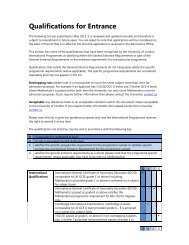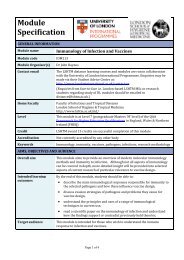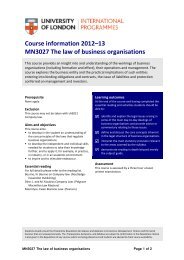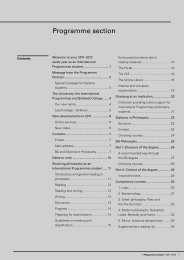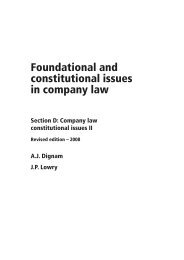Introduction to computer systems architecture and programming
Introduction to computer systems architecture and programming
Introduction to computer systems architecture and programming
You also want an ePaper? Increase the reach of your titles
YUMPU automatically turns print PDFs into web optimized ePapers that Google loves.
168 <strong>Introduction</strong> <strong>to</strong> <strong>computer</strong> <strong>systems</strong> <strong>architecture</strong> <strong>and</strong> <strong>programming</strong><br />
14<br />
<strong>programming</strong> skills, <strong>and</strong> you may argue that as long as you underst<strong>and</strong><br />
these fundamentals you will be able <strong>to</strong> instruct a <strong>computer</strong>. However,<br />
this course offers much more than <strong>programming</strong> skills. It also provides<br />
you with the insight in<strong>to</strong> how the <strong>computer</strong> processes the instructions it<br />
receives in the form of program code. As such this course provides a basis<br />
for the ability <strong>to</strong> optimise both the way a <strong>computer</strong> system is programmed<br />
<strong>and</strong> the way it is designed.<br />
To this effect, Chapter 1 first presents some his<strong>to</strong>rical information for you<br />
<strong>to</strong> get an overview of how the first idea of the <strong>computer</strong> came about <strong>and</strong><br />
how it evolved in<strong>to</strong> the kind of <strong>computer</strong> we use <strong>to</strong>day. This chapter then<br />
continues <strong>to</strong> provide an introduction in<strong>to</strong> the fundamental components of<br />
a <strong>computer</strong>’s <strong>architecture</strong>.<br />
An his<strong>to</strong>rical overview of <strong>computer</strong> science<br />
This section provides an overview of the his<strong>to</strong>rical development of the<br />
<strong>computer</strong>. In no way does it claim <strong>to</strong> be exhaustive, but it offers some<br />
initial insights in<strong>to</strong> the main stages of the development of <strong>computer</strong><br />
structure <strong>and</strong> <strong>computer</strong> processes.<br />
Early contributions<br />
The date of the use of the first <strong>computer</strong> is open <strong>to</strong> debate as it depends<br />
on how we define a <strong>computer</strong>. If we base this overview on the search for<br />
the first apparatus that was used within some form of calculation, we<br />
are taken back <strong>to</strong> at least the ancient Greeks <strong>and</strong> Romans who are said<br />
<strong>to</strong> have used the abacus <strong>to</strong> help them with additions <strong>and</strong> subtractions<br />
(Brookshear 2009). However, the abacus is simply a memory support. The<br />
position of the beads merely helps the user <strong>to</strong> remember (or s<strong>to</strong>re) values<br />
used in the calculation.<br />
Since the invention of the abacus, the work of the Scottish mathematician<br />
<strong>and</strong> philosopher John Napier (1550–1617) is often viewed as a significant<br />
contribution <strong>to</strong>wards the development of increasingly sophisticated<br />
calculation devices. John Napier invented the idea of logarithms (remember<br />
from your mathematics lessons at school: if x = y z then log y<br />
x = z) <strong>and</strong><br />
used this concept <strong>to</strong> develop a device (known as Napier’s bones) that<br />
managed <strong>to</strong> reduce the complexity of multiplication <strong>and</strong> division in<strong>to</strong> the<br />
more simple operations of addition <strong>and</strong> subtraction. He did this by taking<br />
advantage of the fact that if a number is expressed in exponential form,<br />
multiplication, for example, can be carried out by adding the exponents (for<br />
example, 10 2 × 10 4 = 10 (2+4) , which is a simplified calculation of 100 ×<br />
10,000). For more detail see www.johnnapier.com/<br />
The first mechanical computing machines<br />
The development of the first mechanical computing machine is<br />
generally considered <strong>to</strong> be the next major step in the advancement of<br />
computing devices, <strong>and</strong> it is the French mathematician <strong>and</strong> philosopher<br />
Blaise Pascal (1623–1662) who is credited with this invention. His<br />
calcula<strong>to</strong>r, also known as the Pascaline, was able <strong>to</strong> add or subtract<br />
two decimal numbers with the help of mechanical gears. The Pascaline<br />
was later developed further by the German mathematician <strong>and</strong><br />
philosopher Gottfried Wilhelm von Leibniz (1646–1716), who added<br />
multiplication <strong>and</strong> division <strong>to</strong> this calcula<strong>to</strong>r.<br />
The English mathematician Charles Babbage (1791–1871) is known for<br />
the development of his Difference Engine <strong>and</strong> the Analytical Engine.<br />
In his Difference Engine Babbage attempted <strong>to</strong> create a machine (the size



